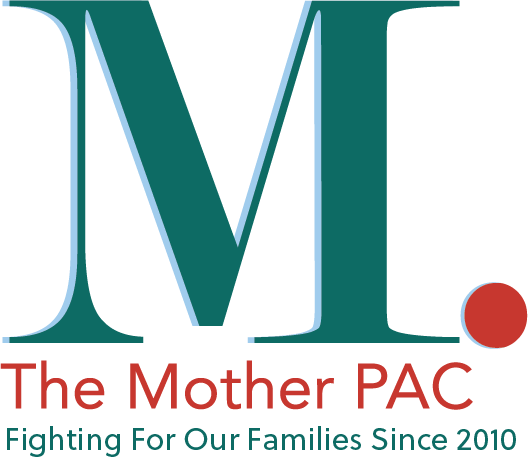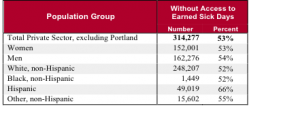We see an Oregon that values its families through strong, family-friendly public policies. One way to turn our vision into reality is to support candidates who share our vision – and are willing to champion the kind of policies today’s families need. Policies that:
- Support the economic security of those providing care to children and others, especially mothers.
- Modernize workplaces and public programs to better support parents and family caregivers.
- Give ALL women and working families a fair shot at getting ahead, not just getting by.
A Little Context on REAL Family Values
American families are in a time and money crunch because the way we work and care has changed dramatically in the last half century — but our public and workplace policies haven’t been updated to reflect the new realities. While the number of women and mothers in the workforce has exploded along with the number of single mothers who head households, our public and workplace policies have utterly failed to keep up.
Unlike most other industrialized nations, the U.S. does not require paid sick time, paid family and medical leave, prohibit family caregiver discrimination, support pregnancy accommodation, or have a working system of affordable, quality childcare. And equal pay for women doing equal work has remained elusive, despite a 50-year old federal law and additional state laws requring it. And the negative economic impacts on women and families are undeniable. Consider these facts:
- Women make up half of the American labor force, for the first time in history.
- 81% of women in America have children by the time they’re forty-four years old.
- Three-quarters of mothers are now in the labor force (half are primary breadwinners for their families; 2/3 are breadwinners or co-breadwinners).
- Mothers earn less than fathers and less than women without children for equal work (60 cents to a father’s dollar).
- Nearly one in five low-wage working moms have lost a job due to sickness or caring for a sick child.
- Over 30% of families led by single moms are living in poverty, compared to 16.4% of families led by single dads.
- Maternal poverty hurts children, too: a majority of the nation’s poor children live in single-mother-led households.
Despite these sobering facts, there hasn’t been enough progress to make a real difference for Oregon mothers and the families who increasingly depend on them. When public policies don’t reflect families’ realities, it is difficult for parents to meet the competing demands of family and work responsibilities without sacrificing one or the other. In other words, our public policies need to be updated to reflect real family values, like most other nations have already done.
The White House hosted a Summit on Working Families on June 23, 2014 to elevate the need for change. And women in Congress have been promoting a “When Women Succeed, America Succeeds” platform to increase pay, paid leave and access to affordable child care, because without these policies, women face significant barriers to higher earnings and promotions to positons of greater responsibility. Despite these high-profile national calls to modernize the nation’s work-family policies, there is also a need to begin in the states, as President Obama said during the Summit:
(In the meantime,) if Congress will not act, we’re going to need mayors to act. We’ll need governors and state legislators to act.
Our 4 Priority Policy Issues for 2014:
- Paid Sick Time
- Affordable quality child care
- Economic security for mothers today and into retirement
- Equal pay for equal work for women — especially mothers and women of color
In 2014, we’re asking state legislative candidates to share their views about and make commitments in 4 policy areas. Why these? Because they’re either urgent for Oregon families or likely to move ahead during the 2015 state legislative session, which begins on February 2, 2015.
1 | Too Many Workers Lack the Right to Earn Paid Sick Time
Everyone gets sick, but not everyone can stay home to recover from illness, see a doctor, or care for a sick child. Last year Portland passed a local “protected sick time” ordinance ensuring all workers have some time to stay home and recover when illness strikes. In July, Eugene passed its own ordinance making it possible for all people working in the city to earn paid sick time. 53% of private-sector workers across Oregon (outside of Portland) lack a single paid sick day from their job. That’s true for nearly 80% of low-wage workers. These working Oregonians don’t have PTO and often lack vacation or any other source of paid time off.
Source: Institute for Women’s Policy Research analysis of 2010–2011 National Health Interview Survey (NHIS) and 2011 IPUMS American Community Survey (ACS).
This means that when an employee (or his/her child) is sick, she must go to work anyway or face financial and, in some cases, disciplinary consequences. As a result, sick employees go to work (and sick children are sent to school and childcare), reducing productivity, spreading illness, and increasing health care costs.
Having the opportunity to earn paid sick time keeps workers employed, respects children’s right to recover at home, protects the public’s health, and helps employers function better. This shouldn’t be a right reserved only for those working and living in Portland – it should be a labor protection for all Oregonians.
2 | Quality Childcare is Increasingly Unaffordable
In 2012, Oregon was rated the least affordable state for center-based infant care. The average cost was greater than 18% of the state median inome for married couples with children. A 2013 report from OSU found that the median cost of child care can cost nearly twice as much as college tuition at Oregon’s public universities ($11,064/year for a toddler vs $6,670 annual college tuition). The same report found that child care costs for Oregon families increased 13% from 2004-12, while household incomes declined 9% (15% for single mothers).
Programs like Employment Related Day Care (ERDC) and our child care tax credits are an important step in helping our state’s most working families afford child care so they can keep working and, while absolutely necessary, we need more. All Oregon families, across the income spectrum, need more access to affordable, high-quality child care.
- Employment Related Day Care (ERDC) is a program that helps eligible low-income working families pay for child care. State estimates indicate that it helps nearly 20,000 families pay for child care every year for approximately 35,000 children. ERDC is effective because it helps parents keep their jobs, helps families access the kind of care they want (whether that is center or home-based), and encourages better quality care. However, the program is not meeting the full need of families who would qualify currently, and the current income thresholds for qualifying for ERDC are too low to help all families who struggle to afford quality childcare.
- The Oregon Working Family Child Care Credit is set to expire without a renewal in 2015. This refundable tax cre
 dit for low-income working families for qualifying child care expenses is one of many ways we currently work to help families afford the child care that helps them keep working.
dit for low-income working families for qualifying child care expenses is one of many ways we currently work to help families afford the child care that helps them keep working.
LEFT: Decreasing Income by: All Households, Married Couples, Single Female-Led Households. RIGHT: Average Child Care Prices in Oregon by Year.
[Source: Child Care and Education in Oregon and Its Counties: 2012. Bobbie Weber, Oregon Child Care Research Partnership.]
Programs like Employment Related Day Care (ERDC) and our child care tax credits are an important step in helping our state’s most working families afford child care so they can keep working and, while absolutely necessary, we need more. All Oregon families, across the income spectrum, need more access to affordable, high-quality child care.
LEARN MORE:
- Child Care and Education in Oregon and Its Counties: 2012
- Childcare challenges in low-wage jobs, National Women’s Law Center
- The Hell of American Day Care, The New Republic
- Hefty Childcare Costs Present Catch-22 for Working Parents, NPR
3 | Women retire poorer than men and motherhood is a leading predictor of poverty in old age.
Financial security in retirement is crucial to women and the families who depend on them. In Oregon alone, eight in ten of the poorest quartile of retirees are women. Women who retire into poverty are less likely to be able to afford basic healthcare, staples like food and heating, and suffer serious health issues as a result. Women in our state need a retirement plan that is available through the workplace, that can be carried from job-to-job without financial penalty, and that they can contribute to even when they are not working (unlike Social Security)- during those  crucial child rearing years that can so often be the difference between a comfortable retirement or one of poverty.
crucial child rearing years that can so often be the difference between a comfortable retirement or one of poverty.
Oregon is considering creating a pooled retirement option for all employees. The proposed state retirement savings plan could contain the following features: portable-employees are able to take the savings with you to another job; low cost to taxpayers; low cost to the participants; professionally managed; accessible to everyone in the state; and easy for contributions to be taken directly from employee paychecks.
[Source: Gould, Elise and Douglas Hall. 2012. Oregon Retirement Security: How are retirement needs being met now and in the future? The Economic Policy Institute. Briefing paper 334.]
- LEARN MORE: Save Today, Secure Tomorrow campaign
4 | Women aren’t being paid equally for equal work.
Nationally women  are paid just 77 cents for every dollar earned by white men (Oregon women earn a slightly higher 79 cents to that dollar). Women of color fare worse, with African-American and Latina women earning 64 and 55 cents, respectively, to the dollar earned by white men. Mothers also fare worse, earning just 69 cents compared to fathers, hitting a maternal wall that affects their lifetime financial security as well as their family’s day-to-day budget.
are paid just 77 cents for every dollar earned by white men (Oregon women earn a slightly higher 79 cents to that dollar). Women of color fare worse, with African-American and Latina women earning 64 and 55 cents, respectively, to the dollar earned by white men. Mothers also fare worse, earning just 69 cents compared to fathers, hitting a maternal wall that affects their lifetime financial security as well as their family’s day-to-day budget.
To begin addressing this problem, the Oregon Council on Civil Rights released a report in January 2014, Pay Inequality in Oregon, that suggests a variety of ways we can take action at the state level to reduce persistent gender and race-based wage gaps.
Part of redressing historic pay inequities is addressing the discrimination women still face in the workforce. We have laws on the books, but Oregon women need more information on their rights and on how to get support when they think they have been discriminated against.
- LEARN MORE: Oregon Commission on Civil Rights 2014 Report, Pay Inequality in Oregon.
- Guest Opinion in The Oregonian on Equal Pay Day, Today women finally catch up to men



